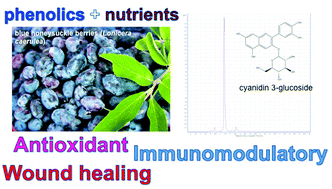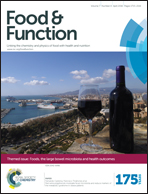Blue honeysuckle fruit (Lonicera caerulea L.) from eastern Russia: phenolic composition, nutritional value and biological activities of its polar extracts
Abstract
In the present work we conducted a comprehensive chemical analysis of blue honeysuckle (Lonicera caerulea) spontaneously growing in eastern Russia. HPLC-DAD-ESI/MS analysis showed cyanidin-3-glucoside as the major constituent among phenolics, while nutritional analysis revealed fibre, protein, calcium and magnesium as the most important macro- and micronutrients, respectively. Fatty acid composition was dominated by polyunsaturated fatty acids, linoleic acid being the most abundant. Furthermore, we evaluated several in vitro biological activities such as antioxidant, antimicrobial, antiproliferative, wound healing and immunomodulatory effects of blue honeysuckle aqueous and ethanolic extracts that are often incorporated in food and nutraceutical preparations. While the fruit extracts were revealed to be potent radical scavengers with significant inhibition of ABTS radical, thus confirming the literature data, their inhibitory effects against microbial pathogens and tumor cell lines were negligible. The fruit aqueous extract did not show toxicity to human fibroblasts, but 24 h treatment with 150–200 μg per mL of extract slightly enhanced the cell migration when tested by scratched wound assay. Worth mentioning was the inhibitory effect displayed by the blue honeysuckle fruit aqueous extract on human lymphocytes.



 Please wait while we load your content...
Please wait while we load your content...